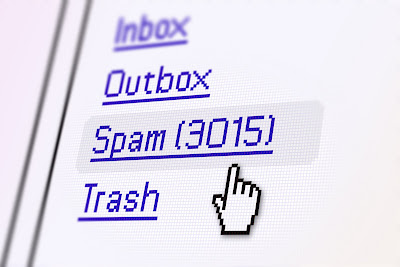Nothing Like Under Estimating How Long A Project Will Take
Monday, March 21, 2011 |
 Edit Post
Edit Post

Time management. A key ingredient to being an effective small business owner or independent contractor. Your time is literally money. You need time to spend on each client and project. And you need to know how effectively to manage all that time, juggle your projects and keep your clients happy.
But there are times when a project balloons out of control. A contractor quits, you run into glitches, simple things become more complex and all of a sudden a project that was supposed to take weeks ends up taking many many weeks. What do you do?
How do you explain it to your client?
You create a contract, you set a deadline, you quote a financial estimate....and none of it matches up. At what point do you bite the bullet and absorb the cost of things, and at what point do you say to your client, "Look, this is far more than we bargained for, and it's going to go over the price quote."
No really, I'm asking you to give me some insight into this kind of situation!
I'm such a giver and a people please-er I don't know when to say, "no." One thing I've learned is to be very very clear on the scope of work. I think there can be some ambiguous loop holes and nothing worse then getting caught in a perpetual loop.
Be precise in what you will and wont do. For instance, today, I was talking with another company and they said to re-wrap their plug-in for the website was free the first two times, but after that they charge. Okay fair enough. How about 2 edits of a website and after that, charge for changes. (Yes I know this is probably typical of most web design firms yet it wasn't spelled out in my contract) This will cause a client to really be clear on what they want on the website. This would be a smart thing to write into my next contract.
Please pass on any sage advice and ideas for creating stronger contracts, better scopes of work, and keeping projects from ballooning out of control, while still keeping clients happy.
Get This
When it Comes to Email Communications: Stop-Breathe-Think-Act
Wednesday, March 16, 2011 |
 Edit Post
Edit Post

Okay everyone, deep breath. I've seen a lot of miss communications via email lately, not just in my business, but others seem to be having the same problems as well when we compare notes. This happens in a fast paced, stress filled environment both on personal and on professional levels. There's a good reason for this. Black and white typed emails are only one third of the story.
Communication is a fragile and tricky thing.
We've gone from personal meetings and phone calls, to emails, texts, facebook communications, and the limited field of twitter as a means to do business. This is great! And this is awful at the same time. In speeding up life, we've lost two thirds of the sensory input in understanding communications. We no longer hear vocal intonation, nor do we see body language or facial expressions.
Just imagine, if you are stressed out and you read an email you may read it with your own tone, not the intended tone of the sender. Same thing if you are frustrated. If you are feeling frustrations, inadequacies, or annoyances on either a personal or a professional level you may transfer this to the reading, and at times the writing, of an email.
When I was teaching scuba diving we used to teach in an underwater stress situation: Stop - Breathe - Think - Act.
Always easier said than done, but it's important to take a step back. Are you really reading what is being said correctly? Or are you reading it through the filters that you have personally put in place that have to do with the things you are going through?
Read all critical communications several times, and read non-critical communications at least once. This goes for receiving and sending. By dashing off an email and sending it without a re-read you may find that either something seems unclear, or something sounds inappropriate when written quickly. Always try to think, how will the other person read this.
And be careful when you write a veiled snide comment to someone. You may think they wont get it, but guess what, they probably will and that will make a situation worse. When you read the written word you are missing 2 thirds of the communication that is actually happening.
When it doubt talk it out.
Get on the phone, have a skype video call, meet in person to discuss the situation. Something small and inadvertent can turn into huge miss interpretations when they go unchecked.
So remember, before you jump to conclusions, Stop - Breathe - Think - Act.
Get This
Successful Email Marketing: Permisson Is The Key
Tuesday, March 01, 2011 |
 Edit Post
Edit Post

Scraping emails off facebook, linkedin, or business cards for your newsletter is not cool. This is why email marketing gets a bad name.
First off the key to correct and effective email marketing is to have a permission based list.
Translation: a list of people who want to get your emails.
Just because someone hands you a business card at a networking event or accepts your friendship on a social network does not mean that you can troll through their personal data and add them to your newsletter.
Huge companies like Constant Contact will shut you down if you get too many spam reports, and people who haven't given you permission in the first place are very likely to report you as spam. Besides, uploading a ton of emails that you haven't earned through generating interest in your product or service defeats the purpose of email marketing.
It's not how many random people you have in your database that counts, it's how many actively engaged people you have in your database that matters.
In fact it's not a bad idea to take the pulse of your database every so often with surveys to see how engaged your audience is with your content. Emails letting them know, "It's okay to unsubscribe....really." Are a great way to see who will take you up on it. What? You are afraid of losing the sheer numbers you have in your database? Don't be. The more targeted your database, the more targeted your message.
Email marketing is still one of the best ways to get yourself in front of your client base, people who request information are interested. Now figure out how to engage them. Use social media to engage the people in your circle who haven't added themselves to your mailing list. If they become interested enough or have a need for your services and information....they will ask to be added.
Get This
Subscribe to:
Posts (Atom)
My World Travel Blog
Twitter Updates
Blog Visitors
Book Mark on Onlywire
Followers